Numeracy and Data Analysis: Analysis of Liverpool's Humidity Data
VerifiedAdded on 2023/01/16
|11
|1615
|65
Homework Assignment
AI Summary
This assignment presents a detailed analysis of humidity data collected over ten consecutive days in Liverpool. The study begins by organizing the data into a table and presenting it graphically. It then proceeds to calculate key statistical measures, including the mean, median, mode, range, and standard deviation of the humidity data, providing interpretations for each. Furthermore, the assignment explores a linear forecasting model to predict future humidity levels, calculating the constants M and C and forecasting humidity for the 15th and 20th days. The study concludes with a summary of the findings and references relevant sources.
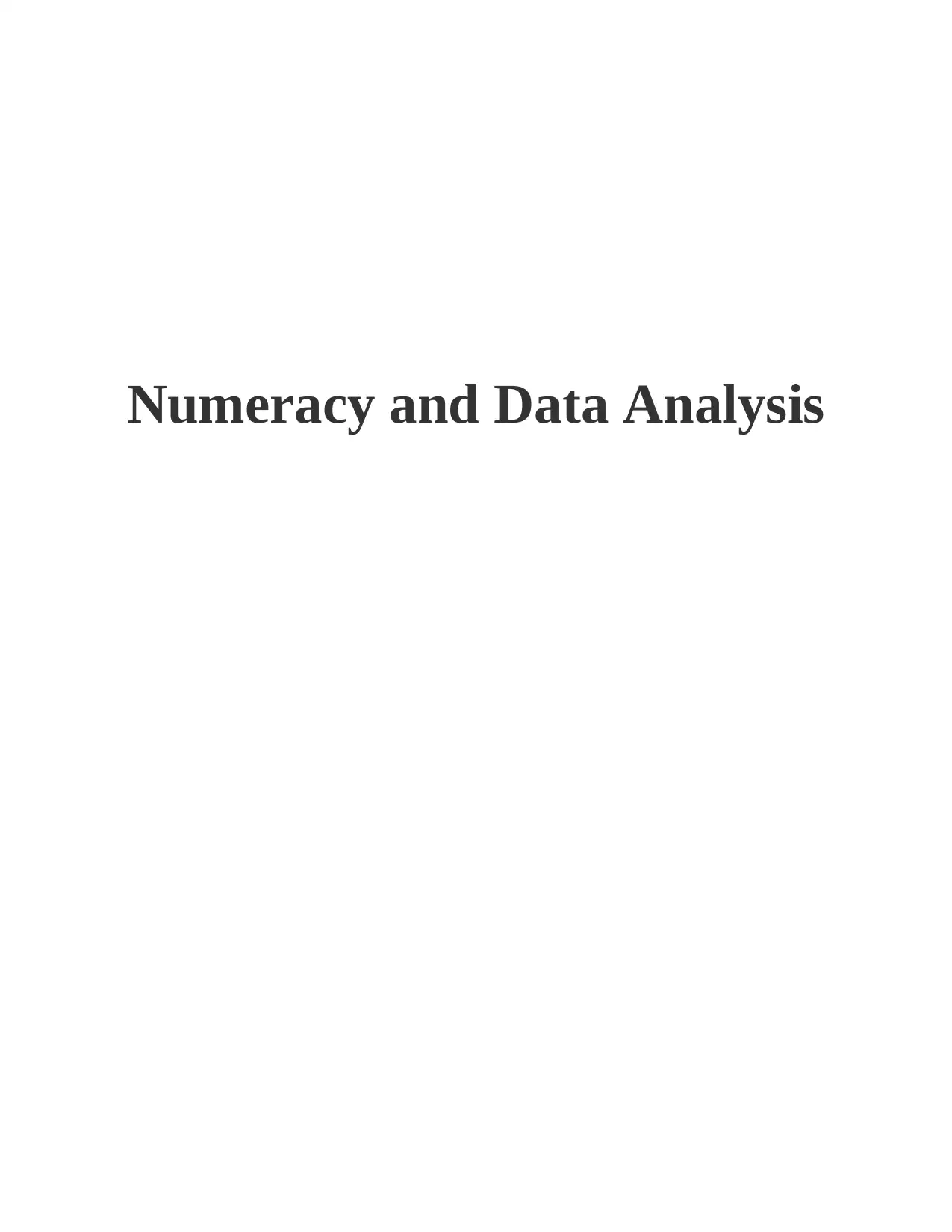
Numeracy and Data Analysis
Paraphrase This Document
Need a fresh take? Get an instant paraphrase of this document with our AI Paraphraser
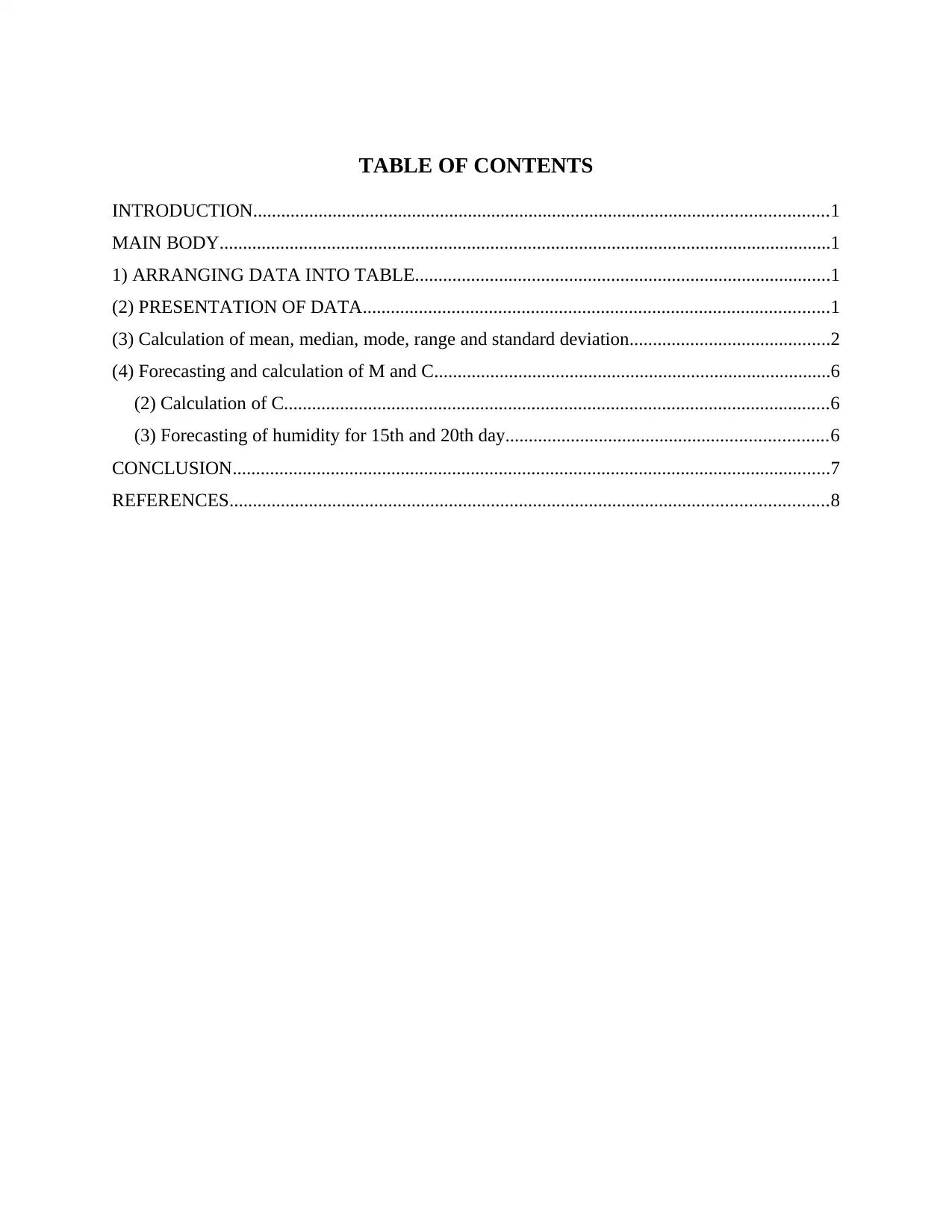
TABLE OF CONTENTS
INTRODUCTION...........................................................................................................................1
MAIN BODY...................................................................................................................................1
1) ARRANGING DATA INTO TABLE.........................................................................................1
(2) PRESENTATION OF DATA....................................................................................................1
(3) Calculation of mean, median, mode, range and standard deviation...........................................2
(4) Forecasting and calculation of M and C.....................................................................................6
(2) Calculation of C.....................................................................................................................6
(3) Forecasting of humidity for 15th and 20th day.....................................................................6
CONCLUSION................................................................................................................................7
REFERENCES................................................................................................................................8
INTRODUCTION...........................................................................................................................1
MAIN BODY...................................................................................................................................1
1) ARRANGING DATA INTO TABLE.........................................................................................1
(2) PRESENTATION OF DATA....................................................................................................1
(3) Calculation of mean, median, mode, range and standard deviation...........................................2
(4) Forecasting and calculation of M and C.....................................................................................6
(2) Calculation of C.....................................................................................................................6
(3) Forecasting of humidity for 15th and 20th day.....................................................................6
CONCLUSION................................................................................................................................7
REFERENCES................................................................................................................................8
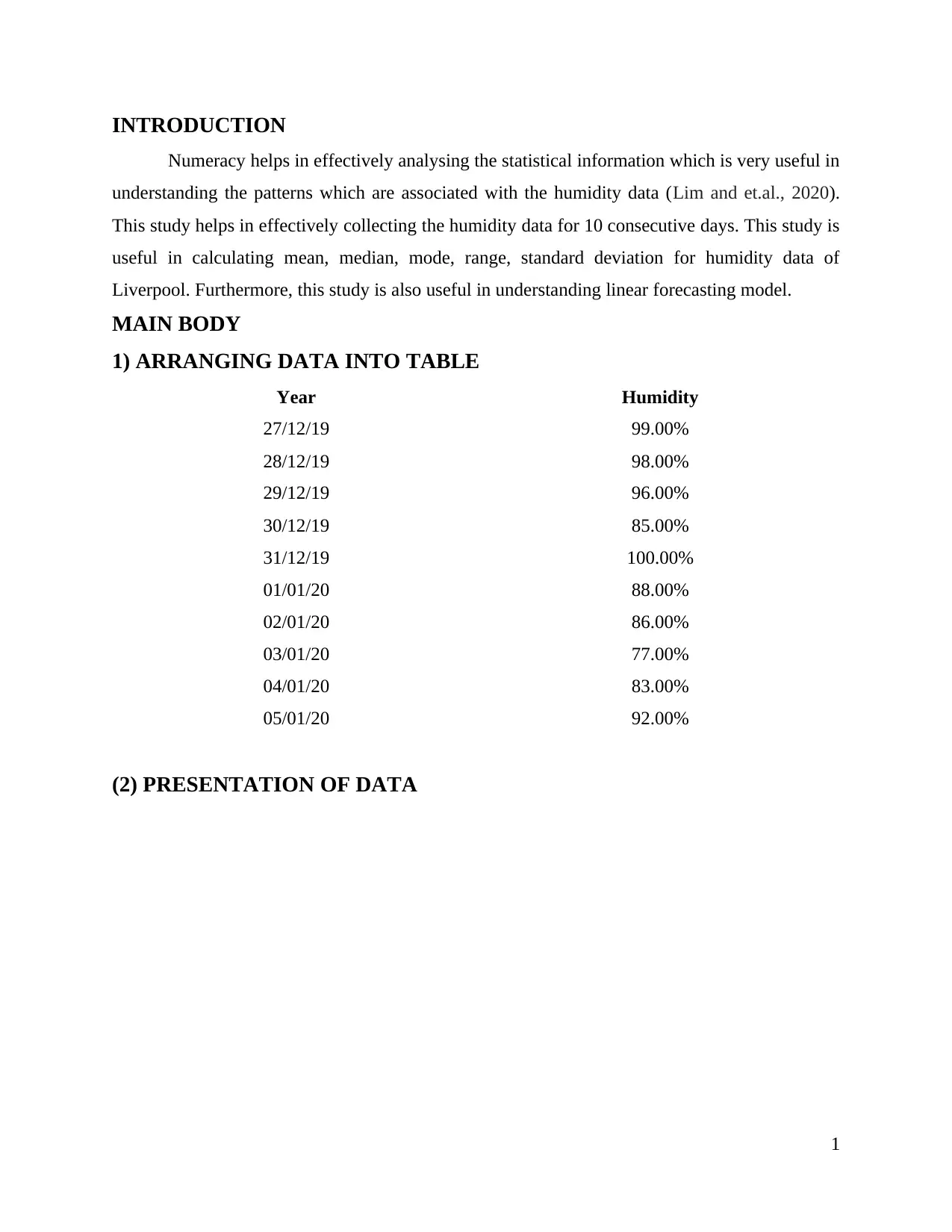
INTRODUCTION
Numeracy helps in effectively analysing the statistical information which is very useful in
understanding the patterns which are associated with the humidity data (Lim and et.al., 2020).
This study helps in effectively collecting the humidity data for 10 consecutive days. This study is
useful in calculating mean, median, mode, range, standard deviation for humidity data of
Liverpool. Furthermore, this study is also useful in understanding linear forecasting model.
MAIN BODY
1) ARRANGING DATA INTO TABLE
Year Humidity
27/12/19 99.00%
28/12/19 98.00%
29/12/19 96.00%
30/12/19 85.00%
31/12/19 100.00%
01/01/20 88.00%
02/01/20 86.00%
03/01/20 77.00%
04/01/20 83.00%
05/01/20 92.00%
(2) PRESENTATION OF DATA
1
Numeracy helps in effectively analysing the statistical information which is very useful in
understanding the patterns which are associated with the humidity data (Lim and et.al., 2020).
This study helps in effectively collecting the humidity data for 10 consecutive days. This study is
useful in calculating mean, median, mode, range, standard deviation for humidity data of
Liverpool. Furthermore, this study is also useful in understanding linear forecasting model.
MAIN BODY
1) ARRANGING DATA INTO TABLE
Year Humidity
27/12/19 99.00%
28/12/19 98.00%
29/12/19 96.00%
30/12/19 85.00%
31/12/19 100.00%
01/01/20 88.00%
02/01/20 86.00%
03/01/20 77.00%
04/01/20 83.00%
05/01/20 92.00%
(2) PRESENTATION OF DATA
1
⊘ This is a preview!⊘
Do you want full access?
Subscribe today to unlock all pages.

Trusted by 1+ million students worldwide
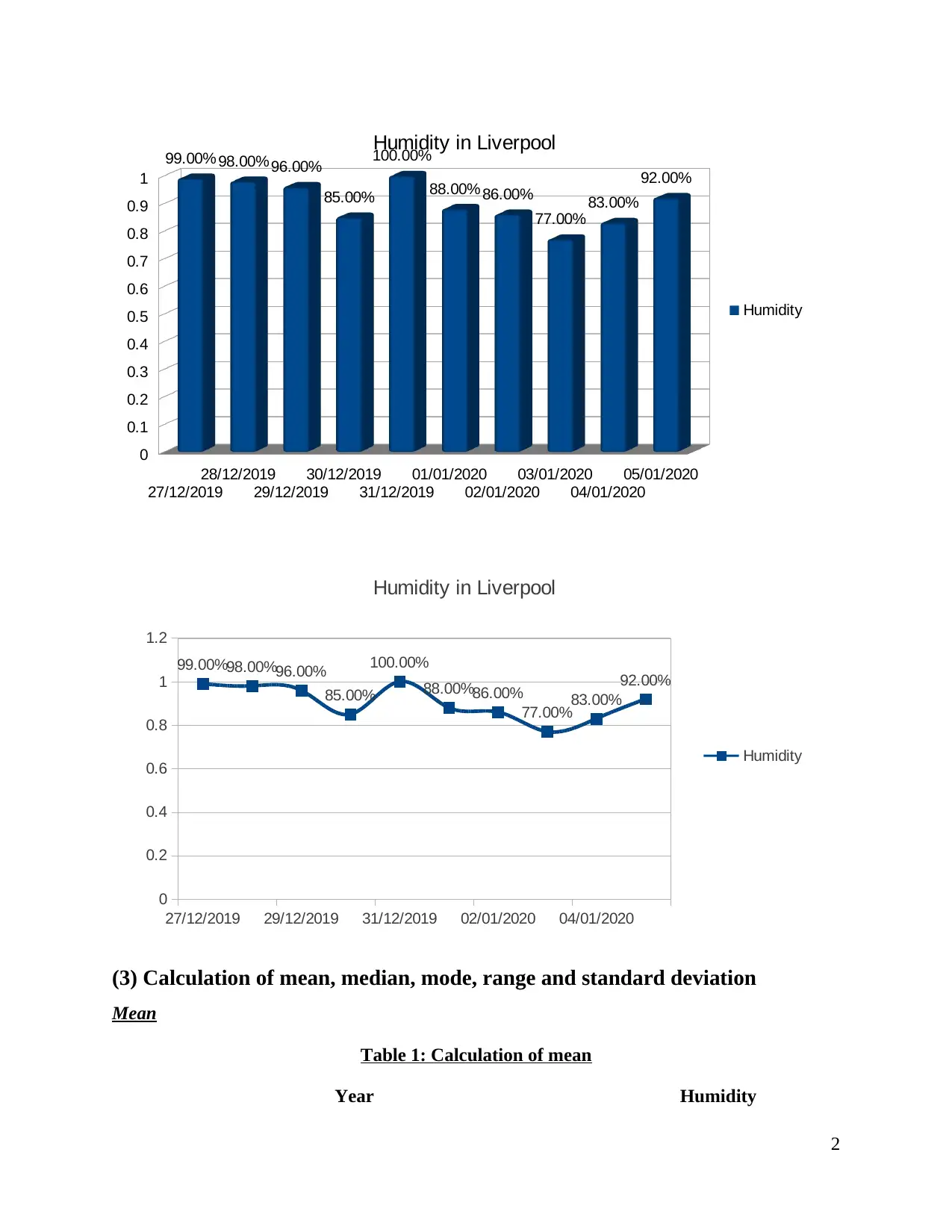
27/12/2019
28/12/2019
29/12/2019
30/12/2019
31/12/2019
01/01/2020
02/01/2020
03/01/2020
04/01/2020
05/01/2020
0
0.1
0.2
0.3
0.4
0.5
0.6
0.7
0.8
0.9
1
99.00% 98.00%96.00%
85.00%
100.00%
88.00% 86.00%
77.00%
83.00%
92.00%
Humidity in Liverpool
Humidity
27/12/2019 29/12/2019 31/12/2019 02/01/2020 04/01/2020
0
0.2
0.4
0.6
0.8
1
1.2
99.00%98.00%96.00%
85.00%
100.00%
88.00%86.00%
77.00%83.00%
92.00%
Humidity in Liverpool
Humidity
(3) Calculation of mean, median, mode, range and standard deviation
Mean
Table 1: Calculation of mean
Year Humidity
2
28/12/2019
29/12/2019
30/12/2019
31/12/2019
01/01/2020
02/01/2020
03/01/2020
04/01/2020
05/01/2020
0
0.1
0.2
0.3
0.4
0.5
0.6
0.7
0.8
0.9
1
99.00% 98.00%96.00%
85.00%
100.00%
88.00% 86.00%
77.00%
83.00%
92.00%
Humidity in Liverpool
Humidity
27/12/2019 29/12/2019 31/12/2019 02/01/2020 04/01/2020
0
0.2
0.4
0.6
0.8
1
1.2
99.00%98.00%96.00%
85.00%
100.00%
88.00%86.00%
77.00%83.00%
92.00%
Humidity in Liverpool
Humidity
(3) Calculation of mean, median, mode, range and standard deviation
Mean
Table 1: Calculation of mean
Year Humidity
2
Paraphrase This Document
Need a fresh take? Get an instant paraphrase of this document with our AI Paraphraser
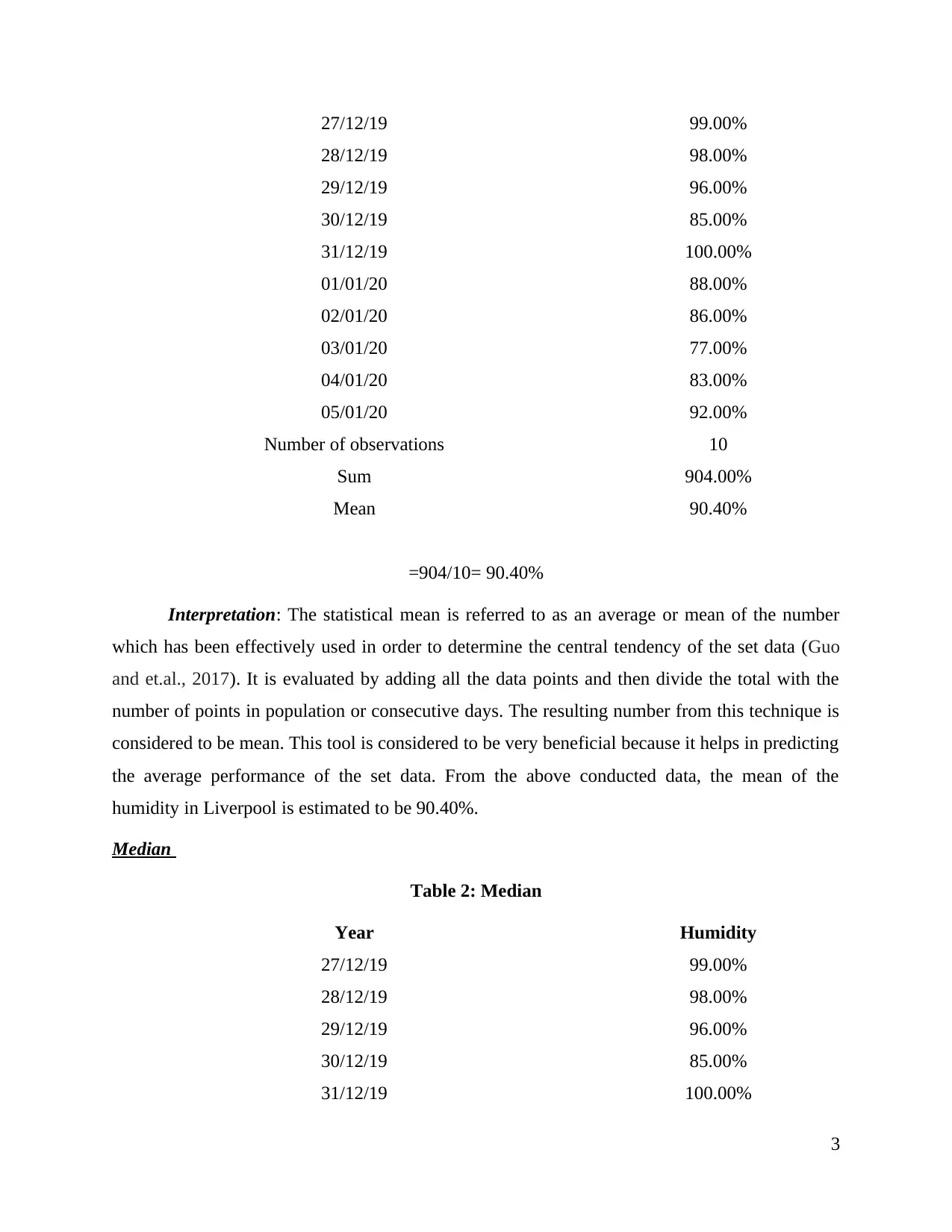
27/12/19 99.00%
28/12/19 98.00%
29/12/19 96.00%
30/12/19 85.00%
31/12/19 100.00%
01/01/20 88.00%
02/01/20 86.00%
03/01/20 77.00%
04/01/20 83.00%
05/01/20 92.00%
Number of observations 10
Sum 904.00%
Mean 90.40%
=904/10= 90.40%
Interpretation: The statistical mean is referred to as an average or mean of the number
which has been effectively used in order to determine the central tendency of the set data (Guo
and et.al., 2017). It is evaluated by adding all the data points and then divide the total with the
number of points in population or consecutive days. The resulting number from this technique is
considered to be mean. This tool is considered to be very beneficial because it helps in predicting
the average performance of the set data. From the above conducted data, the mean of the
humidity in Liverpool is estimated to be 90.40%.
Median
Table 2: Median
Year Humidity
27/12/19 99.00%
28/12/19 98.00%
29/12/19 96.00%
30/12/19 85.00%
31/12/19 100.00%
3
28/12/19 98.00%
29/12/19 96.00%
30/12/19 85.00%
31/12/19 100.00%
01/01/20 88.00%
02/01/20 86.00%
03/01/20 77.00%
04/01/20 83.00%
05/01/20 92.00%
Number of observations 10
Sum 904.00%
Mean 90.40%
=904/10= 90.40%
Interpretation: The statistical mean is referred to as an average or mean of the number
which has been effectively used in order to determine the central tendency of the set data (Guo
and et.al., 2017). It is evaluated by adding all the data points and then divide the total with the
number of points in population or consecutive days. The resulting number from this technique is
considered to be mean. This tool is considered to be very beneficial because it helps in predicting
the average performance of the set data. From the above conducted data, the mean of the
humidity in Liverpool is estimated to be 90.40%.
Median
Table 2: Median
Year Humidity
27/12/19 99.00%
28/12/19 98.00%
29/12/19 96.00%
30/12/19 85.00%
31/12/19 100.00%
3
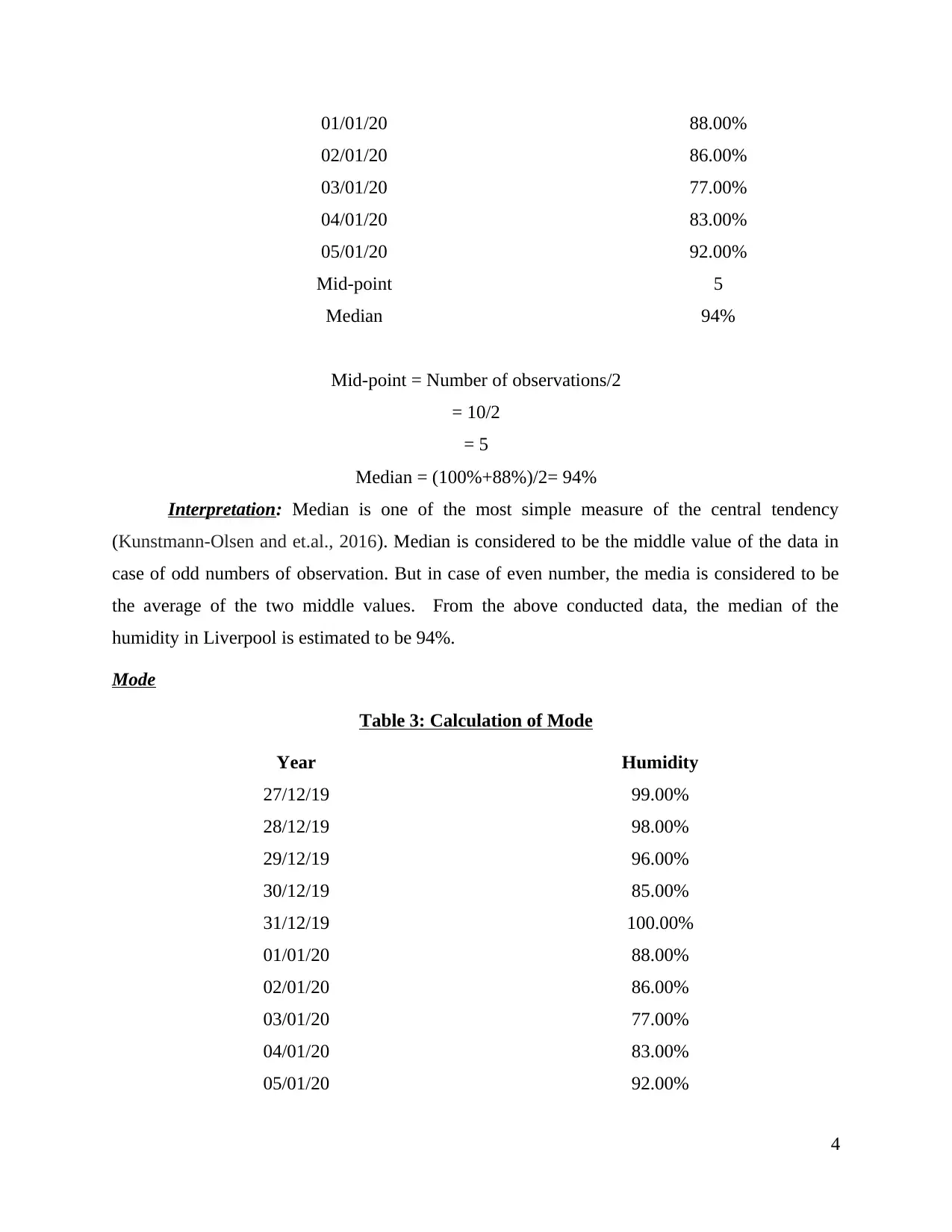
01/01/20 88.00%
02/01/20 86.00%
03/01/20 77.00%
04/01/20 83.00%
05/01/20 92.00%
Mid-point 5
Median 94%
Mid-point = Number of observations/2
= 10/2
= 5
Median = (100%+88%)/2= 94%
Interpretation: Median is one of the most simple measure of the central tendency
(Kunstmann-Olsen and et.al., 2016). Median is considered to be the middle value of the data in
case of odd numbers of observation. But in case of even number, the media is considered to be
the average of the two middle values. From the above conducted data, the median of the
humidity in Liverpool is estimated to be 94%.
Mode
Table 3: Calculation of Mode
Year Humidity
27/12/19 99.00%
28/12/19 98.00%
29/12/19 96.00%
30/12/19 85.00%
31/12/19 100.00%
01/01/20 88.00%
02/01/20 86.00%
03/01/20 77.00%
04/01/20 83.00%
05/01/20 92.00%
4
02/01/20 86.00%
03/01/20 77.00%
04/01/20 83.00%
05/01/20 92.00%
Mid-point 5
Median 94%
Mid-point = Number of observations/2
= 10/2
= 5
Median = (100%+88%)/2= 94%
Interpretation: Median is one of the most simple measure of the central tendency
(Kunstmann-Olsen and et.al., 2016). Median is considered to be the middle value of the data in
case of odd numbers of observation. But in case of even number, the media is considered to be
the average of the two middle values. From the above conducted data, the median of the
humidity in Liverpool is estimated to be 94%.
Mode
Table 3: Calculation of Mode
Year Humidity
27/12/19 99.00%
28/12/19 98.00%
29/12/19 96.00%
30/12/19 85.00%
31/12/19 100.00%
01/01/20 88.00%
02/01/20 86.00%
03/01/20 77.00%
04/01/20 83.00%
05/01/20 92.00%
4
⊘ This is a preview!⊘
Do you want full access?
Subscribe today to unlock all pages.

Trusted by 1+ million students worldwide
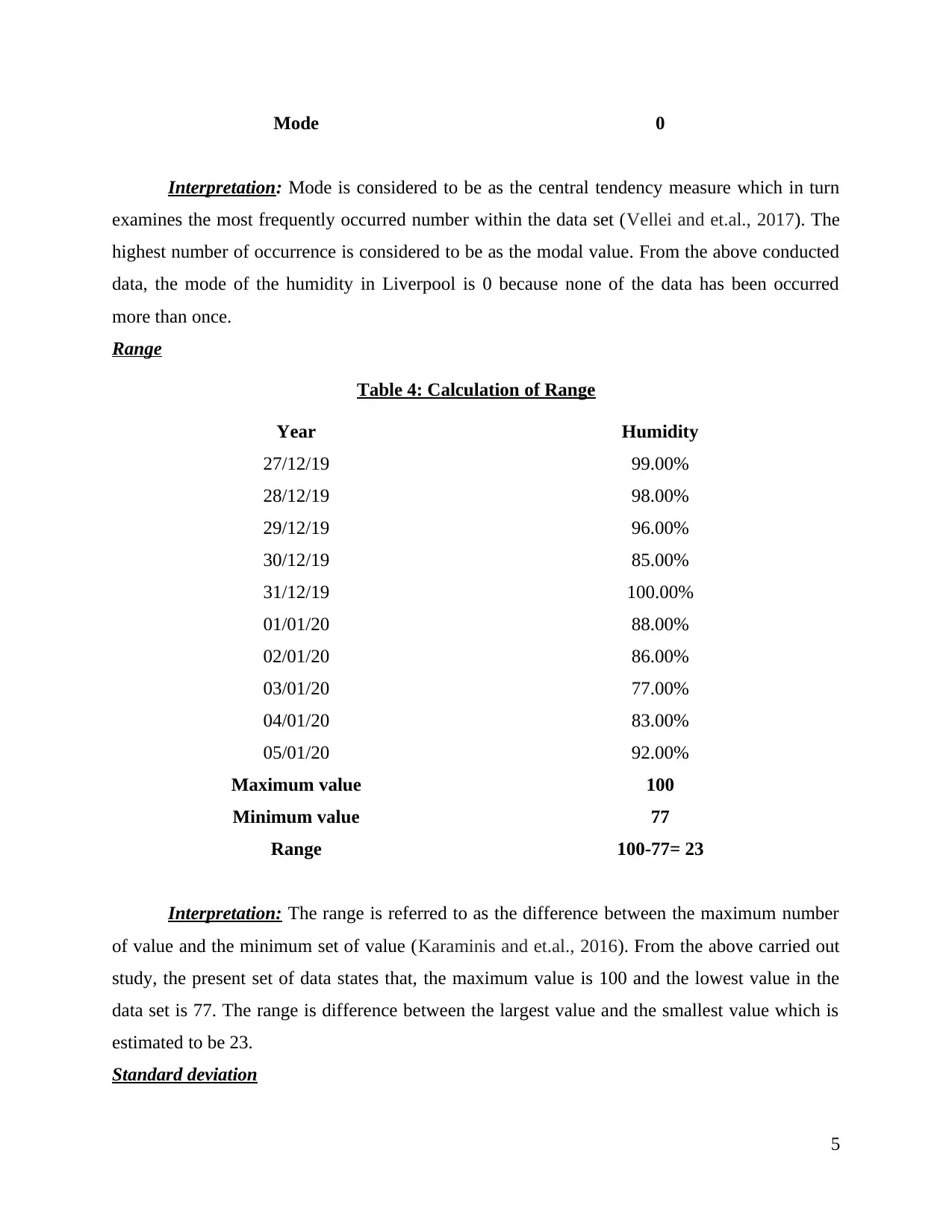
Mode 0
Interpretation: Mode is considered to be as the central tendency measure which in turn
examines the most frequently occurred number within the data set (Vellei and et.al., 2017). The
highest number of occurrence is considered to be as the modal value. From the above conducted
data, the mode of the humidity in Liverpool is 0 because none of the data has been occurred
more than once.
Range
Table 4: Calculation of Range
Year Humidity
27/12/19 99.00%
28/12/19 98.00%
29/12/19 96.00%
30/12/19 85.00%
31/12/19 100.00%
01/01/20 88.00%
02/01/20 86.00%
03/01/20 77.00%
04/01/20 83.00%
05/01/20 92.00%
Maximum value 100
Minimum value 77
Range 100-77= 23
Interpretation: The range is referred to as the difference between the maximum number
of value and the minimum set of value (Karaminis and et.al., 2016). From the above carried out
study, the present set of data states that, the maximum value is 100 and the lowest value in the
data set is 77. The range is difference between the largest value and the smallest value which is
estimated to be 23.
Standard deviation
5
Interpretation: Mode is considered to be as the central tendency measure which in turn
examines the most frequently occurred number within the data set (Vellei and et.al., 2017). The
highest number of occurrence is considered to be as the modal value. From the above conducted
data, the mode of the humidity in Liverpool is 0 because none of the data has been occurred
more than once.
Range
Table 4: Calculation of Range
Year Humidity
27/12/19 99.00%
28/12/19 98.00%
29/12/19 96.00%
30/12/19 85.00%
31/12/19 100.00%
01/01/20 88.00%
02/01/20 86.00%
03/01/20 77.00%
04/01/20 83.00%
05/01/20 92.00%
Maximum value 100
Minimum value 77
Range 100-77= 23
Interpretation: The range is referred to as the difference between the maximum number
of value and the minimum set of value (Karaminis and et.al., 2016). From the above carried out
study, the present set of data states that, the maximum value is 100 and the lowest value in the
data set is 77. The range is difference between the largest value and the smallest value which is
estimated to be 23.
Standard deviation
5
Paraphrase This Document
Need a fresh take? Get an instant paraphrase of this document with our AI Paraphraser
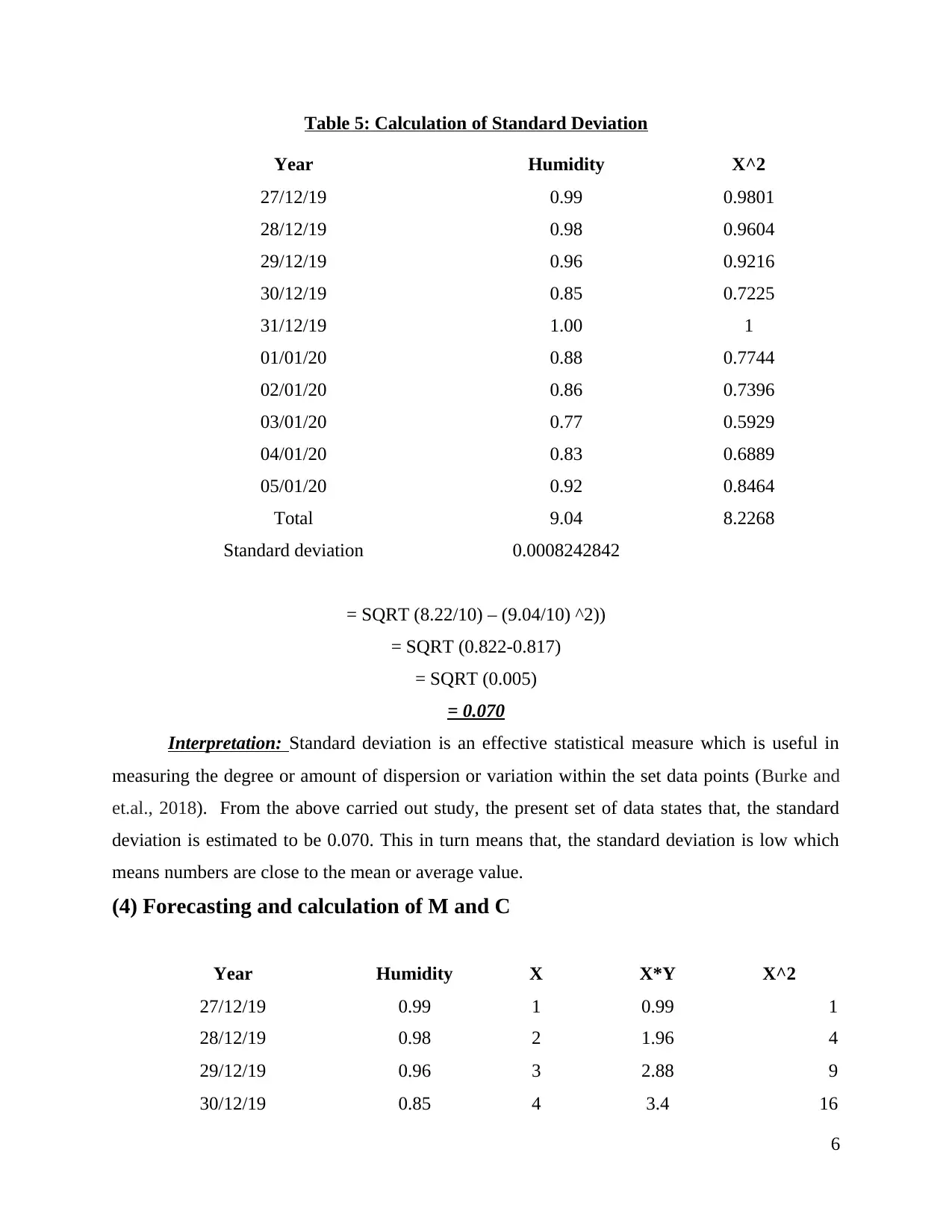
Table 5: Calculation of Standard Deviation
Year Humidity X^2
27/12/19 0.99 0.9801
28/12/19 0.98 0.9604
29/12/19 0.96 0.9216
30/12/19 0.85 0.7225
31/12/19 1.00 1
01/01/20 0.88 0.7744
02/01/20 0.86 0.7396
03/01/20 0.77 0.5929
04/01/20 0.83 0.6889
05/01/20 0.92 0.8464
Total 9.04 8.2268
Standard deviation 0.0008242842
= SQRT (8.22/10) – (9.04/10) ^2))
= SQRT (0.822-0.817)
= SQRT (0.005)
= 0.070
Interpretation: Standard deviation is an effective statistical measure which is useful in
measuring the degree or amount of dispersion or variation within the set data points (Burke and
et.al., 2018). From the above carried out study, the present set of data states that, the standard
deviation is estimated to be 0.070. This in turn means that, the standard deviation is low which
means numbers are close to the mean or average value.
(4) Forecasting and calculation of M and C
Year Humidity X X*Y X^2
27/12/19 0.99 1 0.99 1
28/12/19 0.98 2 1.96 4
29/12/19 0.96 3 2.88 9
30/12/19 0.85 4 3.4 16
6
Year Humidity X^2
27/12/19 0.99 0.9801
28/12/19 0.98 0.9604
29/12/19 0.96 0.9216
30/12/19 0.85 0.7225
31/12/19 1.00 1
01/01/20 0.88 0.7744
02/01/20 0.86 0.7396
03/01/20 0.77 0.5929
04/01/20 0.83 0.6889
05/01/20 0.92 0.8464
Total 9.04 8.2268
Standard deviation 0.0008242842
= SQRT (8.22/10) – (9.04/10) ^2))
= SQRT (0.822-0.817)
= SQRT (0.005)
= 0.070
Interpretation: Standard deviation is an effective statistical measure which is useful in
measuring the degree or amount of dispersion or variation within the set data points (Burke and
et.al., 2018). From the above carried out study, the present set of data states that, the standard
deviation is estimated to be 0.070. This in turn means that, the standard deviation is low which
means numbers are close to the mean or average value.
(4) Forecasting and calculation of M and C
Year Humidity X X*Y X^2
27/12/19 0.99 1 0.99 1
28/12/19 0.98 2 1.96 4
29/12/19 0.96 3 2.88 9
30/12/19 0.85 4 3.4 16
6
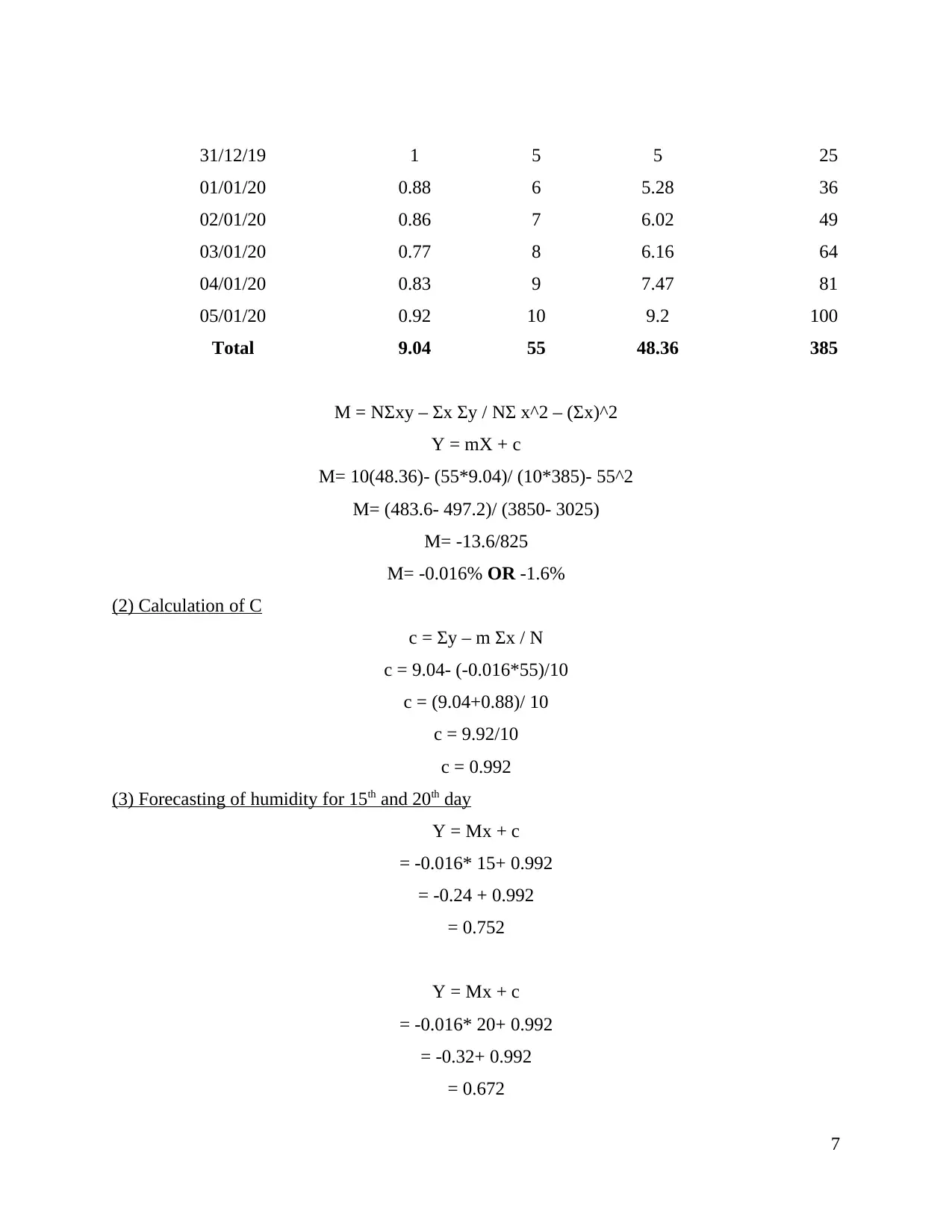
31/12/19 1 5 5 25
01/01/20 0.88 6 5.28 36
02/01/20 0.86 7 6.02 49
03/01/20 0.77 8 6.16 64
04/01/20 0.83 9 7.47 81
05/01/20 0.92 10 9.2 100
Total 9.04 55 48.36 385
M = NΣxy – Σx Σy / NΣ x^2 – (Σx)^2
Y = mX + c
M= 10(48.36)- (55*9.04)/ (10*385)- 55^2
M= (483.6- 497.2)/ (3850- 3025)
M= -13.6/825
M= -0.016% OR -1.6%
(2) Calculation of C
c = Σy – m Σx / N
c = 9.04- (-0.016*55)/10
c = (9.04+0.88)/ 10
c = 9.92/10
c = 0.992
(3) Forecasting of humidity for 15th and 20th day
Y = Mx + c
= -0.016* 15+ 0.992
= -0.24 + 0.992
= 0.752
Y = Mx + c
= -0.016* 20+ 0.992
= -0.32+ 0.992
= 0.672
7
01/01/20 0.88 6 5.28 36
02/01/20 0.86 7 6.02 49
03/01/20 0.77 8 6.16 64
04/01/20 0.83 9 7.47 81
05/01/20 0.92 10 9.2 100
Total 9.04 55 48.36 385
M = NΣxy – Σx Σy / NΣ x^2 – (Σx)^2
Y = mX + c
M= 10(48.36)- (55*9.04)/ (10*385)- 55^2
M= (483.6- 497.2)/ (3850- 3025)
M= -13.6/825
M= -0.016% OR -1.6%
(2) Calculation of C
c = Σy – m Σx / N
c = 9.04- (-0.016*55)/10
c = (9.04+0.88)/ 10
c = 9.92/10
c = 0.992
(3) Forecasting of humidity for 15th and 20th day
Y = Mx + c
= -0.016* 15+ 0.992
= -0.24 + 0.992
= 0.752
Y = Mx + c
= -0.016* 20+ 0.992
= -0.32+ 0.992
= 0.672
7
⊘ This is a preview!⊘
Do you want full access?
Subscribe today to unlock all pages.

Trusted by 1+ million students worldwide
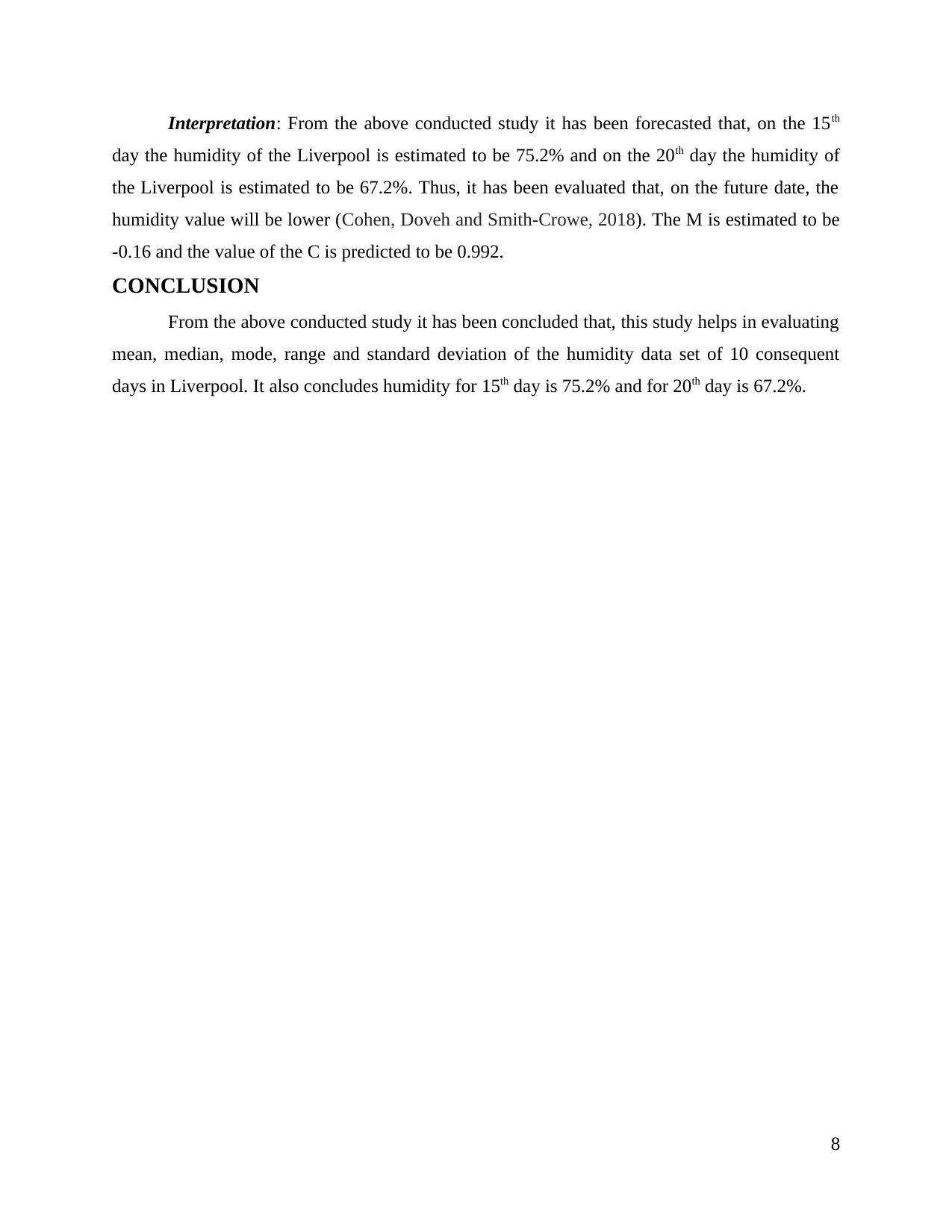
Interpretation: From the above conducted study it has been forecasted that, on the 15th
day the humidity of the Liverpool is estimated to be 75.2% and on the 20th day the humidity of
the Liverpool is estimated to be 67.2%. Thus, it has been evaluated that, on the future date, the
humidity value will be lower (Cohen, Doveh and Smith-Crowe, 2018). The M is estimated to be
-0.16 and the value of the C is predicted to be 0.992.
CONCLUSION
From the above conducted study it has been concluded that, this study helps in evaluating
mean, median, mode, range and standard deviation of the humidity data set of 10 consequent
days in Liverpool. It also concludes humidity for 15th day is 75.2% and for 20th day is 67.2%.
8
day the humidity of the Liverpool is estimated to be 75.2% and on the 20th day the humidity of
the Liverpool is estimated to be 67.2%. Thus, it has been evaluated that, on the future date, the
humidity value will be lower (Cohen, Doveh and Smith-Crowe, 2018). The M is estimated to be
-0.16 and the value of the C is predicted to be 0.992.
CONCLUSION
From the above conducted study it has been concluded that, this study helps in evaluating
mean, median, mode, range and standard deviation of the humidity data set of 10 consequent
days in Liverpool. It also concludes humidity for 15th day is 75.2% and for 20th day is 67.2%.
8
Paraphrase This Document
Need a fresh take? Get an instant paraphrase of this document with our AI Paraphraser
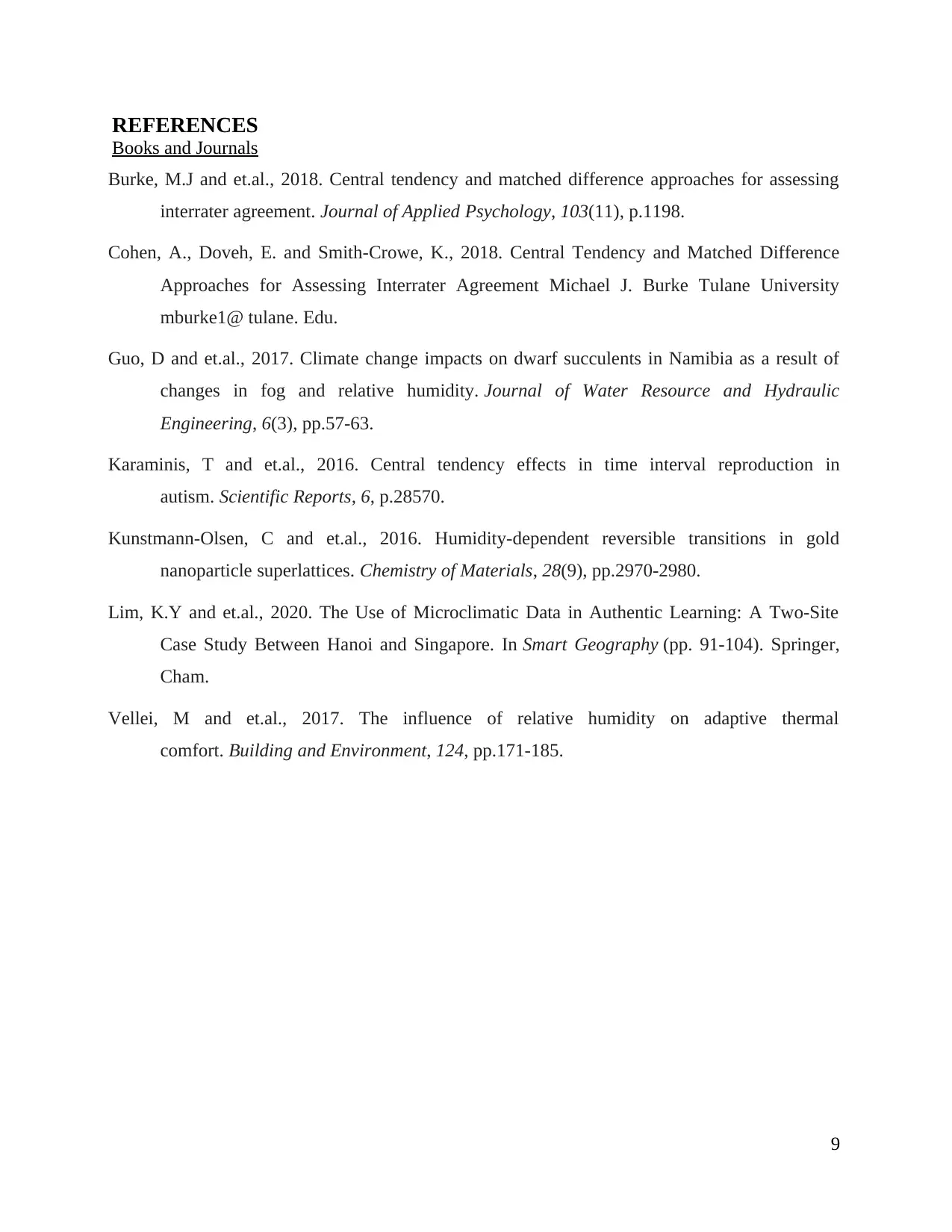
REFERENCES
Books and Journals
Burke, M.J and et.al., 2018. Central tendency and matched difference approaches for assessing
interrater agreement. Journal of Applied Psychology, 103(11), p.1198.
Cohen, A., Doveh, E. and Smith-Crowe, K., 2018. Central Tendency and Matched Difference
Approaches for Assessing Interrater Agreement Michael J. Burke Tulane University
mburke1@ tulane. Edu.
Guo, D and et.al., 2017. Climate change impacts on dwarf succulents in Namibia as a result of
changes in fog and relative humidity. Journal of Water Resource and Hydraulic
Engineering, 6(3), pp.57-63.
Karaminis, T and et.al., 2016. Central tendency effects in time interval reproduction in
autism. Scientific Reports, 6, p.28570.
Kunstmann-Olsen, C and et.al., 2016. Humidity-dependent reversible transitions in gold
nanoparticle superlattices. Chemistry of Materials, 28(9), pp.2970-2980.
Lim, K.Y and et.al., 2020. The Use of Microclimatic Data in Authentic Learning: A Two-Site
Case Study Between Hanoi and Singapore. In Smart Geography (pp. 91-104). Springer,
Cham.
Vellei, M and et.al., 2017. The influence of relative humidity on adaptive thermal
comfort. Building and Environment, 124, pp.171-185.
9
Books and Journals
Burke, M.J and et.al., 2018. Central tendency and matched difference approaches for assessing
interrater agreement. Journal of Applied Psychology, 103(11), p.1198.
Cohen, A., Doveh, E. and Smith-Crowe, K., 2018. Central Tendency and Matched Difference
Approaches for Assessing Interrater Agreement Michael J. Burke Tulane University
mburke1@ tulane. Edu.
Guo, D and et.al., 2017. Climate change impacts on dwarf succulents in Namibia as a result of
changes in fog and relative humidity. Journal of Water Resource and Hydraulic
Engineering, 6(3), pp.57-63.
Karaminis, T and et.al., 2016. Central tendency effects in time interval reproduction in
autism. Scientific Reports, 6, p.28570.
Kunstmann-Olsen, C and et.al., 2016. Humidity-dependent reversible transitions in gold
nanoparticle superlattices. Chemistry of Materials, 28(9), pp.2970-2980.
Lim, K.Y and et.al., 2020. The Use of Microclimatic Data in Authentic Learning: A Two-Site
Case Study Between Hanoi and Singapore. In Smart Geography (pp. 91-104). Springer,
Cham.
Vellei, M and et.al., 2017. The influence of relative humidity on adaptive thermal
comfort. Building and Environment, 124, pp.171-185.
9
1 out of 11
Related Documents
Your All-in-One AI-Powered Toolkit for Academic Success.
+13062052269
info@desklib.com
Available 24*7 on WhatsApp / Email
![[object Object]](/_next/static/media/star-bottom.7253800d.svg)
Unlock your academic potential
© 2024 | Zucol Services PVT LTD | All rights reserved.





